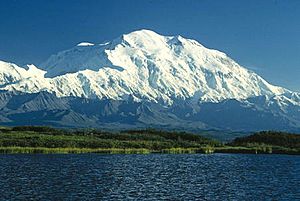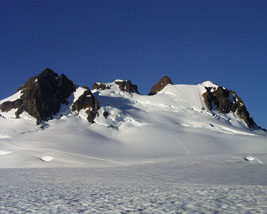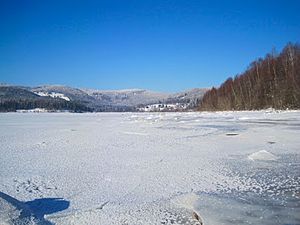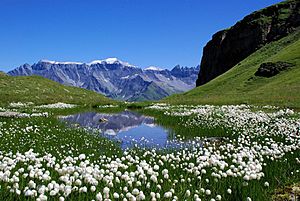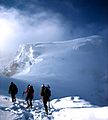Mountain facts for kids
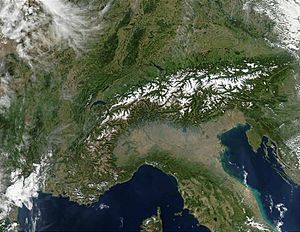
A mountain is a natural rise of the Earth's surface. It usually has a "summit" or "top." Mountains are typically steeper and taller than a hill. People often consider a landform a mountain if it is over 600 metres (about 2,000 feet) tall.
Contents
What is a Mountain?
The highest point of a mountain is called the peak. A mountain's summit is the highest area a person can reach. For example, a mountain climber might reach the summit but not the very peak.
Many encyclopedias say a mountain is usually over 2,000 feet (610 m) tall. In England, the official height for a mountain is 600 metres. This height is important because people have the "Right to Roam" in mountains. This means they can walk freely there, unlike on private land.
How Mountains Form: Geology
Mountains are formed by powerful forces deep within the Earth. There are three main types: volcanic, fold, and block mountains. All of them are created by plate tectonics. This is when huge pieces of the Earth's outer layer, called the crust, move, crash, or slide past each other. These movements push surface rock upwards, creating tall landforms. Major mountains often appear in long lines, showing where these tectonic plates meet and are active.
Volcanic Mountains

Volcanoes form when one Earth plate slides under another. They can also form at mid-ocean ridges or over hotspots. About 100 kilometers (60 miles) deep, rocks melt and form magma. This magma then rises to the surface. When magma reaches the surface, it often builds a volcanic mountain. Examples include shield volcanoes or stratovolcanoes. Famous volcanic mountains are Mount Fuji in Japan and Mount Pinatubo in the Philippines. Sometimes, magma solidifies underground and still forms mountains, like dome mountains such as Navajo Mountain in the USA.
Fold Mountains
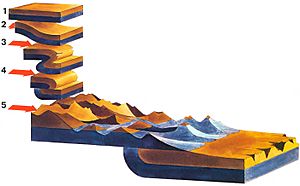
Fold mountains happen when two Earth plates crash into each other. This collision causes the Earth's crust to shorten and thicken. Imagine pushing a rug from both ends; it will wrinkle and fold. The Earth's crust does something similar. The lighter continental crust "floats" on the denser mantle below. So, when crustal material is forced up to make mountains, a much larger volume is pushed down into the mantle. This is why the continental crust is usually much thicker under mountains. The rock can fold in different ways. The upward folds are called anticlines, and the downward folds are synclines. The Jura Mountains are a great example of fold mountains.
Block Mountains
Block mountains are created by faults in the Earth's crust. A fault is a crack where rocks have moved past each other. When rocks on one side of a fault rise compared to the other side, a mountain can form. The raised blocks are called block mountains or horsts. The sunken blocks between them are called graben. These can be small or form large rift valley systems. You can see this type of landscape in East Africa, the Vosges Mountains, and the Basin and Range Province in Western North America.
Erosion: Shaping Mountains
After mountains are pushed up, they are constantly shaped by erosion. Erosion is the process where water, wind, ice, and gravity slowly wear down the uplifted land. This means the surface of mountains is often "younger" than the rocks that make up the mountains themselves. Glaciers create unique mountain shapes like sharp peaks, knife-edge ridges, and bowl-shaped hollows called cirques, which can hold lakes. Some mountains, like the Catskills, are actually plateaus that have been deeply carved by erosion.
Erosion is when natural forces like water flow or wind remove soil, rock, or dissolved material from one place. Then, they transport it to another location. This is different from weathering, which breaks down rock but doesn't move it. When rock or soil breaks into small pieces, it's called physical erosion. When material dissolves into water and is carried away, it's chemical erosion. Eroded material can travel short distances or thousands of kilometers.
Mountain Climate
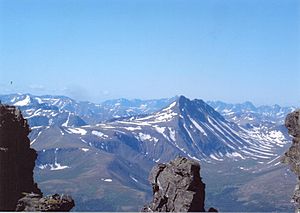
The climate on mountains gets colder as you go higher. This is because of how heat moves in the air. Sunlight heats the ground, and the ground then heats the air near it. Hot air tends to expand and become lighter, so it rises. As this air rises, the pressure gets lower, and the air cools down. This is why mountain tops are usually much colder than their bases.
Moving up 100 meters (about 330 feet) on a mountain is roughly like moving 80 kilometers (50 miles) closer to the North or South Pole. This means that as you climb higher, the weather becomes more like what you'd find in colder parts of the world. As altitude increases, the main type of precipitation becomes snow, and the winds get stronger.
Mountain Life: Ecology
The colder climate on mountains greatly affects the plants and animals that live there. Different plants and animals are suited to specific temperature ranges. Because of this, ecosystems on mountains tend to form in bands based on elevation, each with its own climate. This is called altitudinal zonation. In dry areas, mountains often get more rain and have lower temperatures, which makes these elevation bands even more distinct.
Some plants and animals in these altitudinal zones become isolated. The conditions above and below their zone are too harsh for them to move easily. These isolated ecosystems are sometimes called sky islands.
Altitudinal zones usually follow a pattern. At the very highest elevations, trees cannot grow. The life found here is of the alpine type, similar to a tundra. Just below the tree line, you might find subalpine forests. These are often made up of needleleaf trees, which can handle cold, dry weather. Below that are montane forests. In cooler parts of the world, these are also needleleaf trees. But in tropical areas, they can be broadleaf trees growing in a rain forest.
Mountain Height
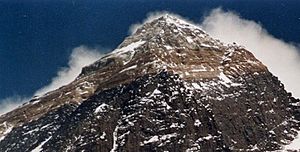
The height of a mountain is usually measured as its distance above sea level.
Tallest Mountains Around the World
The highest mountain in our Solar System is Olympus Mons on Mars, which is an amazing 27 km (17 miles) tall!
On Earth, the highest mountain measured from sea level is Mount Everest. It stands at 8,848 meters (29,031 feet) and is located in Nepal and Tibet in Asia.
However, the "tallest" mountain in the world, measured from its base (even if underwater), is Mauna Loa in Hawaii. Much of this volcano is hidden beneath the Pacific Ocean!
Here are some of the highest mountains on each continent:
- North America: Mount McKinley (6,194m / 20,322 ft) in Alaska, USA.
- South America: Aconcagua (6,962m / 22,841 ft) in Argentina.
- Africa: Kilimanjaro (5,963m / 19,564 ft) in Tanzania.
- Europe: Elbrus (5,633m / 18,510 ft) in Russia.
- Antarctica: Vinsin Massiff (5,140m / 16,864 ft).
- Oceania: Puncak Jaya (5,030m / 16,024 ft) in Papua New Guinea / Indonesia.
Images for kids
-
Mount Everest, Earth's highest mountain
-
Mount Fuji, Japan's highest mountain
-
Mount Kilimanjaro in Tanzania, Africa's highest mountain
-
Peaks of Mount Kenya
-
Mount Elbrus, the highest mountain in Russia and Europe
-
Puncak Jaya in Indonesia, the highest mountain in Oceania
-
Mount Siguniang, Sichuan, China
-
Mount Ararat in Turkey, as seen from Khor Virap, Armenia
-
Mountaineers climbing in South Tyrol
-
Chimborazo, Ecuador. The point on Earth's surface farthest from its centre.
See also
 In Spanish: Montaña para niños
In Spanish: Montaña para niños


